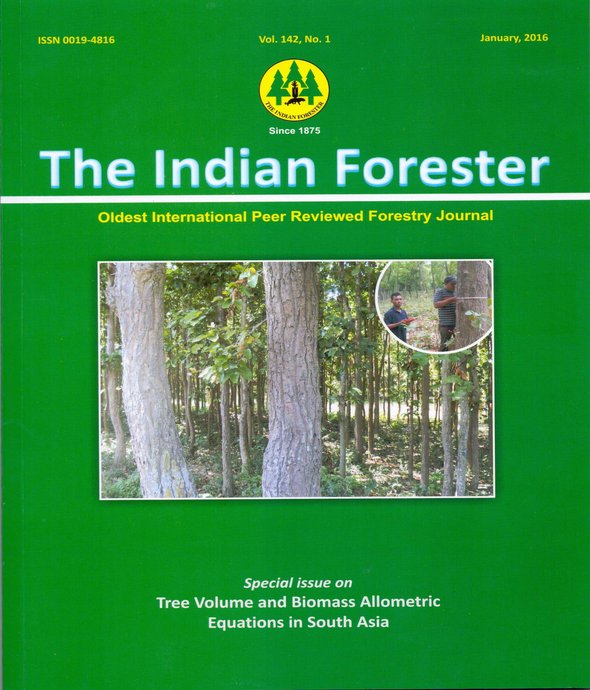Basal Area and Diameter Increment in Long Term Research Sites in Tropical Forests of India
DOI:
https://doi.org/10.36808/if/2016/v142i1/87146Keywords:
Basal Area, Diameter Increment, Tropical forests, Long Term Research.Abstract
Estimates of basal area in long term research sites of tropical forests, basal area increment and pattern of mortality in tropical rain forests (TRF) and rate of diameter growth in different forest types is given. estimates of basal area ranged 2 around 43m2/ha in tropical rain forests to around 30-35 m2/ha in moist deciduous forests and around 13 mm2/ha in dry deciduous forests. the rate of basal area increment per year in tropical rain forests for the pioneer species was 5.3%, canopy species 3.22%, middle storey species 2.02% and for under storey species 1.87%. the overall rate of basal area increment was 2.06 % per year in TRFs of western ghats of india. the average rate of diameter increment for species in the western ghat ranged between 3 to 3.5 mm per year.References
FIP (French Institute Pondicherry) (Undated).Some Results on the Diameter Growth of 59 Endemics of the Medium Elevation Wet Evergreen Forests in the Western Ghats.: 32.
Mathauda G.S. (1955). The contribution and rate of growth of a Tropical Moist Deciduous Forests in South Chanda Division, Madhya Pradesh. Indian Forester, 81: 604-619.
Mathauda G.S. (1958). The un-even aged Sal forests of Ram Nagar forest Division, Uttar Pradesh: their constitution, Rate of growth and drain along with empirical yield and stand tables for selection type of Sal crops. Indian Forester, 84: 255-269.
Rai S.N. (1978). Rate of growth of Dalbergia latifoliaand Xylia dolabriformis. Malaysian Forester, 41:24-253.
Rai S.N. (1979). Rate of growth of Hopea parviflora. My Forest, 15: 31-39.
Rai S.N. (1979). Rate of diameter growth and age/diameter relationship of Vitex altissima and Lannea coromandelica in Moist Deciduous Forests of Karnataka. Indian Journal of Ecology, 6: 20-29.
Rai S.N. (1980). Diameter increment of Terminalia paniculata and Lagerstroemia lanceolata. Indian Forester, 16: 856-864.
Rai S.N. (1981a). Floristic composition and survival pattern of Tropical Rain Forest tree species of India. My Forest, 19: 88-96.
Rai S.N.(1981b). Rate of growth of some evergreen species. Indian Forester, 108: 513-518.
Rai S.N. (1983). Basal area and volume increment in Tropical Rain Forests of India. Indian Forester, 109:198-211.
Rai S.N. (1985). Diameter increment of Terminalia alata and Careya arborea in Moist Deciduous Forests of Western Ghats of Karnataka. Journal of Tropical Forestry, 1:29-39.
Rai S.N. (1989). Rate of diameter growth of trees in humid tropics of Western Ghats of India. In: Proceedings of the Seminar of Growth and yield in Tropical Mixed Moist Forests. (Eds) (Wan Razli, H.T. Chan and S. Appanah) FRIM, Kuala Lumpur.: 106-116.
Rai S.N. and Sharma C.R. (1986). Periodic annual diameter increment in Sandalwood (Santalum album). Van Vigyan, 24: 69-74.
Rai S.N. (1987). Rate of Diameter Increment and Age-Diameter Relationship of Dillenia pentagyna and Grewia tiliaefolia. Journal of Tropical Forestry, 3:160-167.
Rai S.N. and Sharma C.R. (1990). Periodic annual diameter increment in Tectona grandis and Xylia dolabriformis in Moist Deciduous Forests of Karnataka. Journal of Tropical Forestry, 3:208-216.
Rai S.N. (1996).Long Term Research Sites in Tropical Forest of India. UNESCO New Delhi.: 98
Downloads
Downloads
Published
How to Cite
Issue
Section
License
Unless otherwise stated, copyright or similar rights in all materials presented on the site, including graphical images, are owned by Indian Forester.





